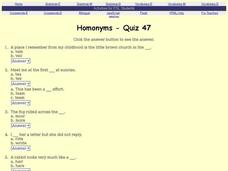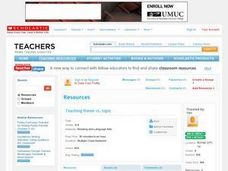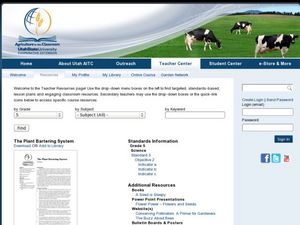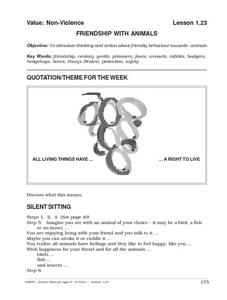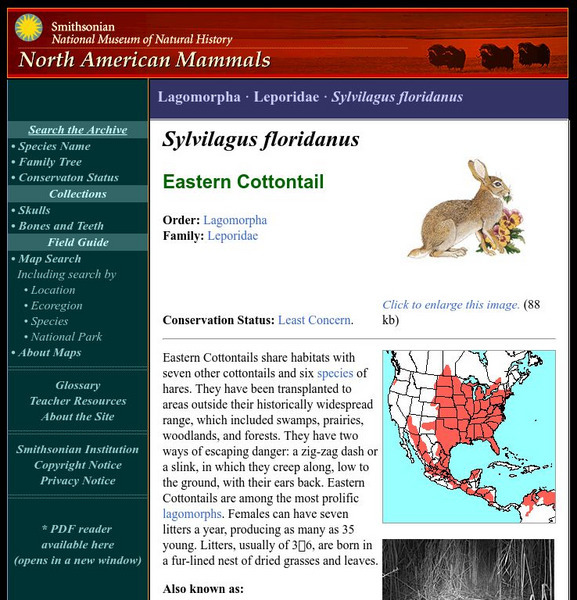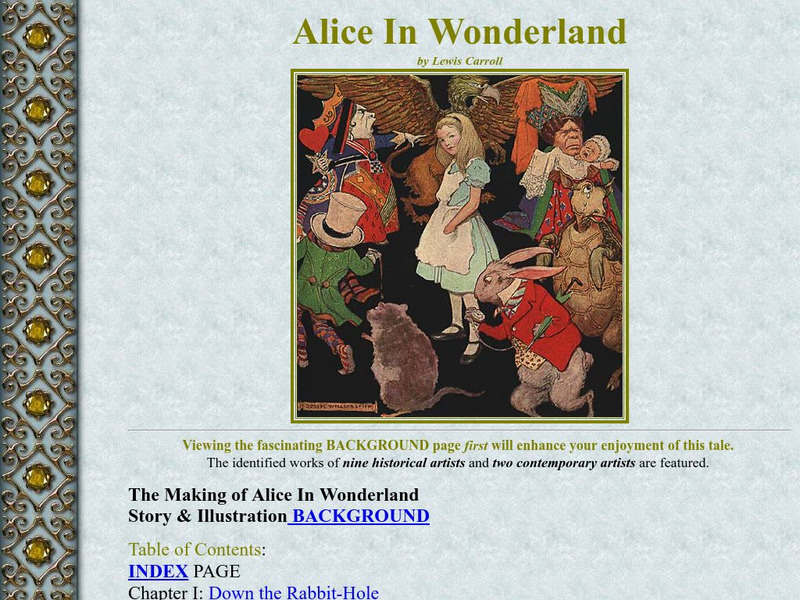Curated OER
Animal Life Histories Derived From Morphology
Learners learn the mechanisms of natural selection by deducing information from the physical appearance of the animal.
Curated OER
Medieval Life: Food
For this historical worksheet, learners read a one page detailed text pertaining to food in the Medieval era. There are no questions to answer.
Curated OER
Let's Read! Tops & Bottoms
Pupils listen to the story Tops & Bottoms and learn the name of one vegetable which grows above ground and one which grows below ground.
Curated OER
Easter Pop-Up Card
In this activity worksheet, students color, cut, fold and paste a picture of the Easter bunny to make a card. Teachers are given a brief history of the holiday and traditions associated with it.
Curated OER
Creating a WebPage (In Spanish)
Students develop a webpage in Spanish. They are introduced to HTML and must have at least three links on their page. They also insert graphics to make their webpage more appealing.
Curated OER
Personification Stories
Young scholars create a clay object in which they are to personify. They use their own personal experiences to help the viewer imagine what it would be like to be that particular object. They also watch videos of fables to help them with...
Curated OER
Homonyms and Homophones
For this grammar worksheet, students study the definitions of homonyms and homophones. They look at examples of both types of words before matching the homonyms and homophones from a word bank with their definitions. They complete and...
Curated OER
Biology Trivia
Students answer questions. In this biology lesson, students answer various questions pertaining to biology.
Curated OER
Homonyms - Quiz 3
In this homonyms worksheet, students fill in the blanks to sentences with the correct homonym. Students complete 20 multiple choice questions.
Curated OER
Homonyms -- Quiz
In this grammar instructional activity, students are assessed on their knowledge of homonyms. Students choose a homonym to complete the sentence.
Curated OER
Theme vs. Topic
Students use Aesop's fables to examine theme and topic. In this theme and topic lesson, students read different fables and discussing as a class. After hearing more stories students work in pairs to determine the theme or topic.
Curated OER
Bird Buffet
Fifth graders study traits of different bird beaks. In this bird instructional activity, 5th graders explore the function and usefulness of different inherited traits of birds.
Curated OER
Specialized Structures and Environments
Fifth graders explore biology by completing an Internet activity in class. In this adaptation lesson, 5th graders identify several organisms and mammals that fight for their existence through slow changes to their anatomy over the course...
Curated OER
Vermicomposting
Fifth graders explore agriculture by viewing compost related presentations. In this worm and soil lesson, 5th graders identify the relationship between good soil and the worms who inhabit it by reading assigned text in class. Students...
Curated OER
Fox hunting debate
Students read the internet article "Hundreds of Hunts Out Despite Ban". The teacher then holds a class discussion about it. Students then hold a formal debate representing all points of view on the issues. Students then write a...
Curated OER
Homonym Practice
In this homonym worksheet, students complete sentences, filling in blanks with the correct homonym, choosing from two. A reference web site is given for additional activities.
Curated OER
The Plant Bartering System
Fifth graders explore plant characteristics by viewing a flower and seed presentation. In this environmental adaptation lesson, 5th graders identify specific traits plants have in order to allow them to grow in different climates whether...
Curated OER
Value: Non-Violence - Friendship With Animals
Students discuss the importance of respecting animals and properly providing for their needs. In a class setting, students read a story about animals and identify kind and caring actions toward the animals. After a class sing-a-long,...
A-Z Animals
A Z Animals: Animal Facts: Hare (Lepus Europaeus)
This entry identifies the defining characteristics of Lepus Europaeus, more commonly known as the hare.
Smithsonian Institution
Smithsonian National Zoo: Zoogoer Magazine: A Rabbit Tale
Susan Lumpkin, in her article in Zoogoer Magazine, traces the origins of the Easter Bunny and deals with information related to rabbits in general. Topics covered in her article include Where in the World?, A Rabbit by Any Other Name,...
Canadian Museum of Nature
Canadian Museum of Nature: Arctic Hare Origami Figure
Follow these 13 easy steps to create your own origami figure of an Arctic Fox. A finished example is shown. The instructions may be downloaded in PDF format.
Smithsonian Institution
National Museum of Natural History: American Mammals: Eastern Cottontail
Eastern Cottontails share habitats with seven other cottontails and six species of hares. They have been transplanted to areas outside their historically widespread range, which included swamps, prairies, woodlands, and forests. Learn...
Other
Bedtime Story Classics Alice in Wonderland
This beautiful online edition of the Lewis Carroll classic is written in large text for easy legibility, and includes illustrations from eleven different versions of the story. It also includes background information on the writing of...
Smithsonian Institution
National Museum of Natural History: American Mammals: Fisher
The Fisher is a forest-loving predator that eats anything it can catch, usually small-to-medium-sized rodents, rabbits, hares, and birds. It also eats carrion. Learn more about the Martes pennanti, more commonly known as a Fisher, in...









